Related Research Articles

Quiapo is a district of the city of Manila, in the National Capital Region of the Philippines. Referred to as the "Old Downtown of Manila", Quiapo is home to the Quiapo Church, where the feast of the Black Nazarene is held with millions of people attending annually. Quiapo has also made a name for itself as a place for marketplace bargain hunting.
Gilda Cordero-Fernando was a Filipino writer, publisher, visual artist, fashion designer, theater producer, and social activist known for writing and publishing numerous works exploring Filipino culture, for her influence as a mentor and supporter of many of the Philippines cultural workers, and for her prominent "colorful presence in the Philippine literary scene."
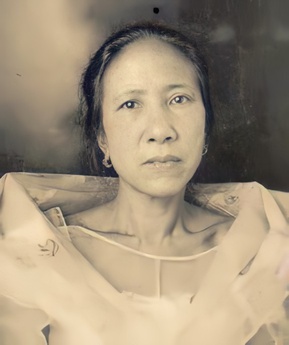
Gregoria de Jesús y Álvarez, also known by her nickname Oriang, was the founder and vice-president of the women's chapter of the Katipunan of the Philippines. She was also the custodian of the documents and seal of the Katipunan. She married Andrés Bonifacio, the Supremo of the Katipunan and President of the Katagalugan Revolutionary Government. She played a major and one of the important roles in the Philippine Revolution. After the death of Bonifacio, she married Julio Nakpil, one of the generals of the revolution. She had one son from Andrés Bonifacio and five children from Julio Nakpil.
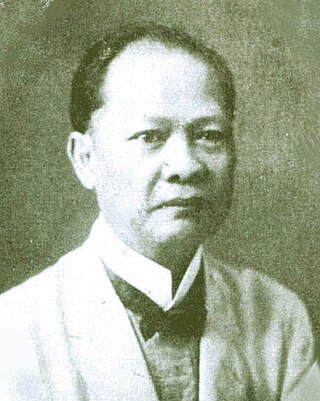
Julio Nakpil y García was a Filipino musician, composer and a General during the Philippine Revolution against Spain. He was a member of the Katipunan, a secret society turned revolutionary government which was formed to overthrow the Spanish government in the Philippines. His Katipunan adoptive name was J. Giliw or simply Giliw. He was commissioned by Andres Bonifacio, President of the Insurgent Tagalog Republic, to compose a hymn which was intended to become the National Anthem of the Tagalog Republic. That hymn was entitled "Marangal na Dalit ng Katagalugan". Thus, to some, he is remembered as the composer of the first national anthem of the Philippines. He is also a known huge critic of Emilio Aguinaldo.
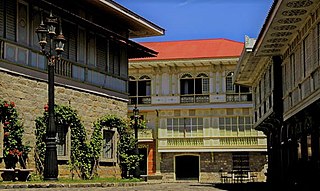
The architecture of the Philippines reflects the historical and cultural traditions in the country. Most prominent historic structures in the archipelago are influenced by Austronesian, Chinese, Spanish, and American architectures.
Juan Felipe de Jesús Nakpil, KGCR known as Juan Nakpil, was a Filipino architect, teacher and a community leader. In 1973, he was named one of the National Artists for architecture. He was regarded as the Dean of Filipino Architects.

In Philippine history, the Tagalog bayan of Maynila was one of the most cosmopolitan of the early historic settlements on the Philippine archipelago. Fortified with a wooden palisade which was appropriate for the predominant battle tactics of its time, it lay on the southern part of the Pasig River delta, where the district of Intramuros in Manila currently stands, and across the river from the separately-led Tondo polity.
Woman With Horns is a short story written by Filipino writer Cecilia Manguerra Brainard. The story was first published in Focus Philippines in 1984 and is part of the author's first short story collection, Woman With Horns and Other Stories. The US edition of Woman With Horns and Other Stories was published in 2020 by PALH/Philippine American Literary House. The title refers to a fictional character named Agustina Macaraig, an Ubecan widow, rumored to have horns. Brainard's character was inspired by fanciful folklore from Cebu, Philippines, where she grew up in and which inspired her to create the setting of many of her stories - Ubec, which is Cebu backwards.

Ancestral houses of the Philippines or Heritage Houses are homes owned and preserved by the same family for several generations as part of the Filipino family culture. It corresponds to long tradition by Filipino people of venerating Ancestors and Elders. Houses could be a simple house to a mansion. The most common ones are the "Bahay na Bato". Some houses of prominent families had become points of interest or museums in their community because of its cultural, architectural or historical significance. These houses that are deemed of significant importance to the Filipino culture are declared Heritage House by the National Historical Commission of the Philippines (NHCP), previously known as the National Historical Institute (NHI) of the Philippines. Preservation is of utmost importance as some ancestral houses have come into danger due to business people who buy old houses in the provinces, dismantle them then sell the parts as ancestral building materials for homeowners wishing to have the ancestral ambiance on their houses. These ancestral houses provide the current generation a look back of the country's colonial past through these old houses.

Quezon Boulevard is a short stretch of highway in Manila, Philippines running north–south through the district of Quiapo. It is a six- to ten-lane 1.1-kilometer-long (0.68 mi) divided boulevard designated as a component of National Route 170 (N170) of the Philippine highway network, except for its service roads, and Radial Road 8 (R-8) of Manila's arterial road network which links the center of Manila to North Luzon Expressway in Quezon City in the north. The boulevard is the main access to the popular Quiapo Church and is one of the main thoroughfares of the University Belt area.

Racism in the Philippines is multifarious and emerged in various portions of the history of people, institutions and territories coinciding to that of the present-day Philippines.
The first full-time mechanical sawmill in the Philippines, the Ascerradura de Mecanica, was opened in the 1880s by Tuason and Sampedro in Gunao Street in Quiapo, a heavily mestizo section of Manila.

The Boix House, also known as Teotico-Crespo House or Casa Boix, is a bahay na bato heritage house located in Quiapo, Manila, the Philippines. Owned by the Philippine Province of the Society of Jesus, the restoration of the house is currently being advocated by the civic group Kapitbahayan sa Kalye Bautista.
The Paterno Ancestral House is a historic house located in Quiapo, Manila, Philippines. The house dates back to the 1870s based on its materials and architectural style. It used to be the next-door neighbor of the Enriquez House which was then located on Hidalgo corner Cancer Streets.

The Nakpil-Bautista House is a bahay na bato ancestral home found in the district of Quiapo, Manila, the Philippines. It was built in 1914 by Arcadio Arellano. The house originally sat on two lots, having a total area of 500 square metres (5,400 sq ft).
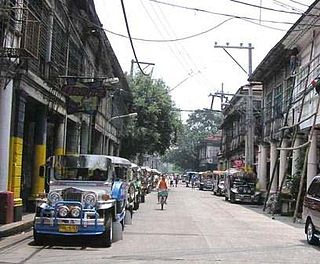
Hidalgo Street is a street located in Quiapo in the old downtown of Manila, Philippines. It runs east–west through the center of the district linking two of the district's most popular landmarks, Quiapo Church and San Sebastian Church. It is divided by Quezon Boulevard into two sections: the western section is a pedestrian zone that forms the southern boundary of Plaza Miranda running parallel to Carriedo Street, while the eastern section is a two-lane street which leads to the San Sebastian Church. Formerly known during the Spanish colonial times in sections as Calle [de] San Sebastian and Calle Crespo, respectively, it was renamed after the Filipino painter Félix Resurrección Hidalgo. It was once considered “the most beautiful street in Manila.”

The indigenous religious beliefs of the Tagalog people were well documented by Spanish missionaries, mostly in the form of epistolary accounts (relaciones) and entries in various dictionaries compiled by missionary friars.
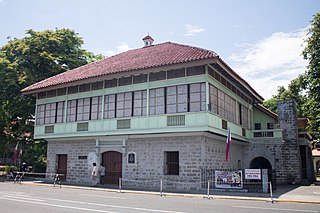
Bahay na bato, also known in Cebuano as balay na bato or balay nga bato and in Spanish as casa Filipino, is a type of building originating during the Spanish colonial period of the Philippines. It is an updated version of the traditional bahay kubo of the Christianized lowlanders, known for its use of masonry in its construction, using stone and brick materials and later synthetic concrete, rather than just full organic materials of the former style. Its design has evolved throughout the ages, but still maintains the bahay kubo's architectural principle, which is adapted to the tropical climate, stormy season, and earthquake-prone environment of the whole archipelago of the Philippines, and fuses it with the influence of Spanish colonizers and Chinese traders. It is one of the many architecture throughout the Spanish Empire known as Arquitectura mestiza. The style is a hybrid of Austronesian, Spanish, and Chinese; and later, with early 20th-century American architecture, supporting the fact that the Philippines is a result of these cultures mixing. Its most common appearance features an elevated, overhanging wooden upper story standing on wooden posts in a rectangular arrangement as a foundation. The posts are placed behind Spanish-style solid stone blocks or bricks, giving the impression of a first floor. Still, the ground level contains storage rooms, cellars, shops, or other business-related functions. The second floor is the elevated residential apartment, as it is with the bahay kubo. The roof materials are either tiled or thatched with nipa, sago palm, or cogon, with later 19th-century designs featuring galvanization. Roof styles are traditionally high pitched and are include the gable roof, hip roof, East Asian hip roof, and the simpler East Asian hip-and-gable roof. Horses for carriages are housed in stables called caballerizas.

Martin Jesus Imperial Tadeo Tinio, Jr. more popularly known as Sonny Tinio, was a Filipino antiquarian, art historian, interior designer, architect, author, and cultural worker. He was best known for chronicling the history of Philippine colonial architecture and Philippine antiquities in various publications in both the Philippines and overseas.

This is a bibliography of works on the Philippines.
References
- ↑ Zialcita, Fernando Nakpil. "Magisterial Lectures | Fernando N Zialcita PhD - The Enlightenment: Still Burning Bright. Areté Ateneo". YouTube .
- 1 2 3 "Zialcita, Fernando N."
- ↑ "Instituto Cervantes to Hold Online Talk on The Filipino Identidad".
- ↑ Zialcita, Fernando N. (2005). Authentic Though Not Exotic: Essays on Filipino Identity. Quezon City.
{{cite book}}: CS1 maint: location missing publisher (link) - 1 2 Zialcita, Fernando N. (2005). "We Are All Mestizos." In Authentic Though Not Exotic: Essays on Filipino Identity. Quezon City: Ateneo de Manila University Press. pp. 211–266.
- 1 2 "THE BAHAY NAKPIL-BAUTISTA FOUNDATION INC".
- ↑ "Philippine Ancestral Houses (1810-1930) by Fernando N. Zialcita".
- ↑ "Forthcoming Titles. Ateneo de Manila University Press".